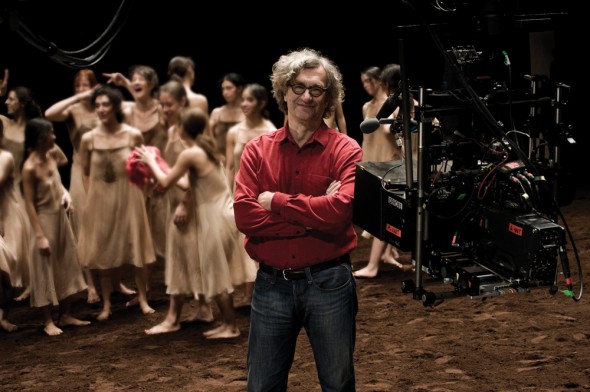
Director Wim Wenders with dancers on the set of PINA, Photography Donata Wenders
On using new technology, the challenges of capturing dance onscreen and the hope for 3D as a tool for future cinematic travel.
Among the world’s greatest filmmakers, Wim Wenders has persistently resisted easy categorization. One of the leading representatives of New German Cinema in the 1970s, he also has to his credit a $20 million sci-fi flop (Until the End of the World), an ill-fated collaboration with Francis Ford Coppola (Hammett) and a series of music documentaries, including his loving portrait of Cuban musicians, Buena Vista Social Club.
Now with nearly 30 feature and non-fiction films to his credit, Wenders has become one of the first European filmmakers to wield 3D digital technology with Pina, his loving portrait of the German choreographer Pina Bausch, who died in June 2009. The documentary débuted at this year’s Berlin International Film Festival and was released stateside by Sundance on April 22nd.
An exuberant, lavishly-produced celebration of Bausch’s work, the film features dancers from her Tanztheater Wuppertal performing scenes from the ensemble’s best-known pieces, including “Café Müller,” “The Rite of Spring” and “Vollmond.” The stereoscopic technology is cleverly married to a fantastical mise en scène that pirouettes off Bausch’s stage and onto the streets, forests and public transportation of Wuppertal and its environs.
Wenders and Bausch had been discussing the possibility of collaborating on a film for roughly 20 years. Both were frustrated, however, by the limitations of two-dimensional cinema, specifically the medium’s inability to create a proper sense of space and depth. “I felt like there was a wall between her art and the essence of it and what it did in every live performance to every viewer I ever met, how it touched us and how it concerned us, that everyone’s soul was open,” Wenders explains during the Berlin Festival over coffee at the Adlon Hotel. “I didn’t think film could do it and my craft couldn’t do it.”

PINA, Photography Laurent Philippe
Wenders’ eureka moment came at the 2007 Cannes Film Festival, where a short 3D film by U2 was screened as part of one of the band’s concerts. “That little film was a sheer revelation for me and I hadn’t expected it. I did not expect technology to open that door,” the director continues. “I almost did not see the film, but I saw the potential of it.”
But technology had a long way to come to allow for the natural space that Wenders wanted to capture. “I wanted a sort of 3D that would disappear and make itself invisible and would just allow us entrance to space itself, which of course was the medium of Pina’s dancers. And so I had high hopes for this technology but it was a use of this technology that was so far unknown,” explains Wenders, expressing his admiration for James Cameron’s Avatar, while admitting that the live-action elements of the film pale in comparison to the animated ones.
“In order to face real life there was no example, there was not much done before and that was right away the biggest challenge because as much as the technology opened the door to space, it had no access to movement,” the director reflects.
Filming in 3D presented its opportunities and challenges. “We had to do our very best through these unknown two eyes [of the 3D camera] to make this emotion stay and reappear on the screen. In a way, the screen became nonexistent because in 3D the screen is gone and you see through it and it becomes a huge window and, of course, that was a new territory—this window into Pina’s work,” says the director, adding that he was guided by a sense of responsibility to Bausch: “I had to answer to myself that question with every shot: was it good enough? This is in its core a documentary and a documentary has a mission. It has the aim of showing something that you like and that you care about as beautiful as possible.”
Wenders says that making the film also helped Bausch’s ensemble process the reality of their founder’s death and move on to the next stage. “They are carrying this heritage and that they are Pina’s work now, because it doesn’t exist outside of this company,” the director says. “Her legacy is her 40 plays. And this company is doing all these plays and they have accepted that they are carrying this treasure and that nobody else can carry it. The film was a crucial step for them to take that responsibility,” he explains.
Wenders feels that there is a happy marriage between 3D and dance, and he is obviously satisfied with the film he stresses that he made for Bausch. To the larger question of whether 3D is merely a fad or something more lasting, Wenders thinks the technology is here to stay. He hopes, however, that directors will use this new tool prudently. “I think the stories will need a certain affinity to it and not every story needs to be told in 3D. I can only say that if I see most of the films today, it doesn’t make sense,” he says sharply.
Where he sees the greatest hope for the medium is not in animation or fantasy blockbusters, but in documentary films. “The core of it is that it gives you a different access also to reality, not just to fantasy, but to reality. I think the glorious application in the future will be a new realm of documentaries,” he elaborates, suggesting that filmmakers will use 3D to transport audiences to faraway places and experiences. Think of it as virtual travel.
This seems to be a view also held by Wenders’ countryman (and fellow New German Cinema veteran) Werner Herzog, who was also brandishing 3D technology at this year’s Berlin Festival with his Cave of Forgotten Dreams, a documentary about Chauvet-Pont-d’Arc, a cave in southern France which contains what are believed to be the oldest paintings and drawings in the world. Wenders has yet to see the film. He missed festival screenings because he was “busy partying” after the Pina premiere.
– A.J. Goldmann

